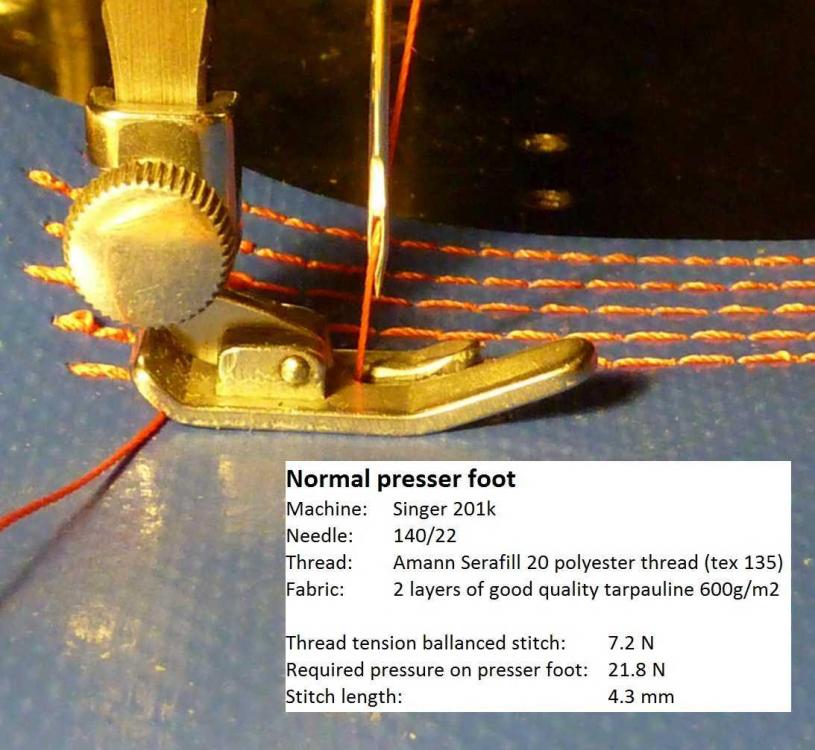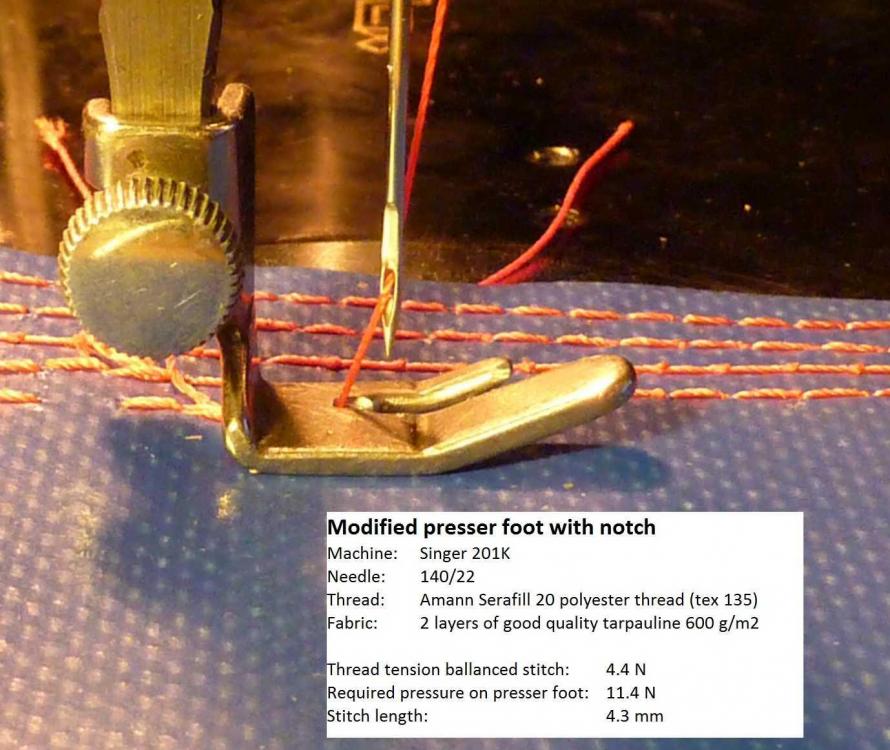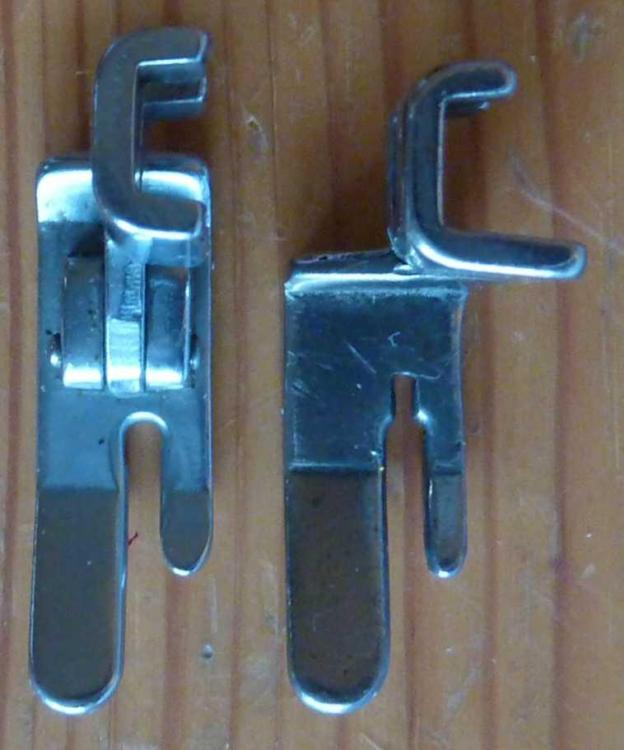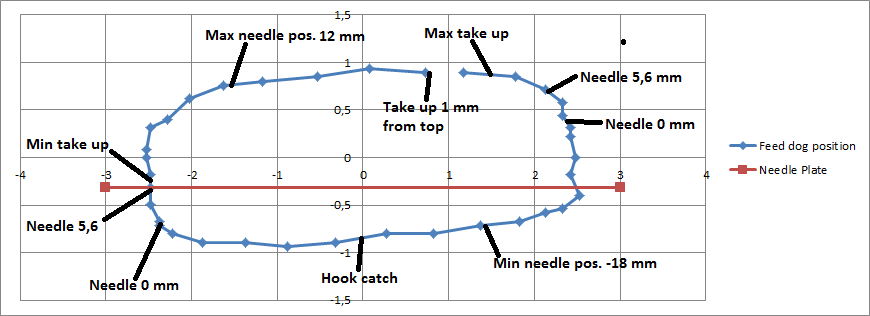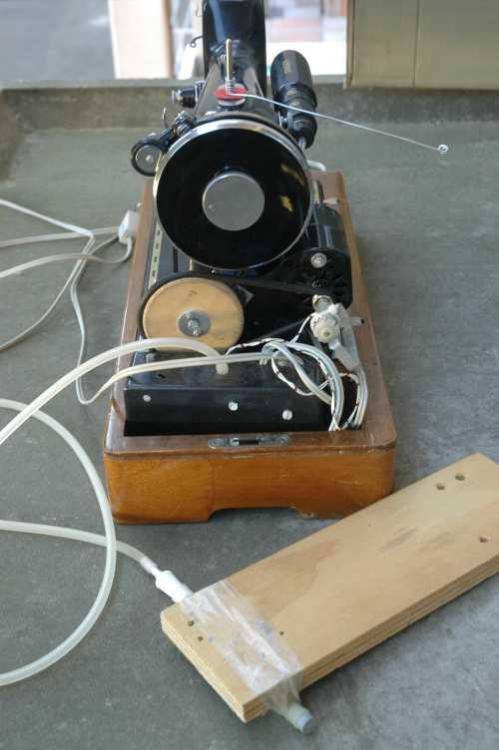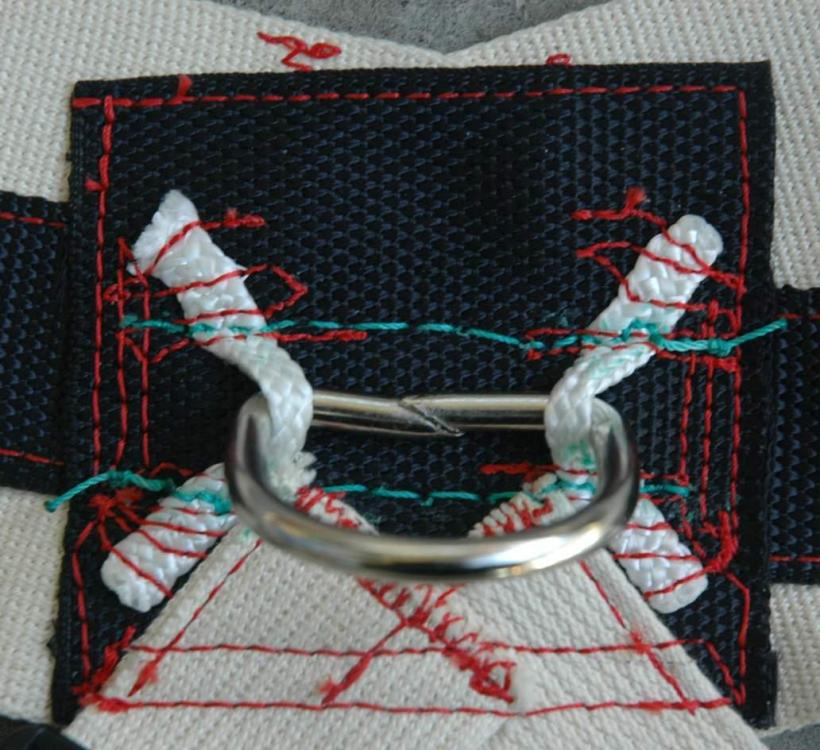
Gymnast
Members-
Posts
287 -
Joined
-
Last visited
Content Type
Profiles
Forums
Events
Blogs
Gallery
Everything posted by Gymnast
-
Thanks trash. If you try it out, I should love to know your results. I have got a supprice myselves. It is hard to believe that such a simple thing is not in use already.
-
Yes, I have got one a 180 W motor on my Singer 201k. But what I got was more a heating element, than a motor. I have with some equipment measured the shaft power of it, and the max power at 230 V was only 52 W at 3800 RPM. Max PRM is at about 12500 RPM. When you buy a motor in this market - and also with servo motors, the watt-value is the input power from the grid. I have not seen how much of it is transformed to shaft power and how much to heat. The main thing to ask for is what is the weight of the motor. The weigt of the 180 W motor I got is 0.5 kg. The manufacturer like to reduce the costs to copper and iron in the motor. And then the efficiency will be lower (more heat less shaft power). So for at 180 W you shall only accept a motor above 1 kg. I have not been using my maschine for hard work in longer periodes, so therefore I have not run into overheating. But I think there is a risk for that with such low weight motor. And one or two times I think it became 100 degr.C. Actually a Chinese manufacturer do make a 250 W motor, and they garanteed a weight of 1.3 kg. So I have considered trying one of those - I would expect the shaft power to be at least 100 W on this: Link to Aliexpress sewing motor
-
Thanks Miker, now you have made a very nice video. I agree with you, that the movements seems odd. I think you need people to Watch this, that have much more specialized knowledge of the same kind of machine. Sorry, I cannot help you.
-
For me it is not too much a problem, that the video is blurry. It is the sudden big steps in the sewing cycle, that causes a problem for me. I hope to see a video with slow movement of every part of the sewing cycle
-
I have looked the video. It seems to me, that when the inner presser foot starts to press, then there is some slack, and then the fabric and feed dog are pushed further a bit backwards. Can i be, that something is Loose?
-
Thank you Gregg, for your adwise. I have been thinking in the same lines as you. I know, that the motor runs on 3x400 VAC - and the owner says, it is a servo motor. But it seems quite big. And there is a lot of pneumatic control things on the machine, and my guess is, that it is outdated. So I think, that the way forward with it is to strip it from the motor and all the air control and get a new servomotor for it. But can I miss something here, that really needs the compressed air? I don't like to have compressed air installed at a the new place for it. My use for it will be mainly repair Work on tarpaulin covers and webbing. The owner said, that the compressed air system also was involved in distributing lubrication oil, but I find that very hard to belive.
-
Thanks for your answer. I am not sure, what you mean by "toys". I think there is some pneumatic functions with the motor, to stop it, to make reverse, securing seam, and thread cutter. Is that what you mean by "toys"?
-
Thanks for your comment dikman. We need to be critical in order to try understan´, what is going on here. I agree, that the different type of feet can make a change to the feed dog traction. Therefore the figures regading required down force on the presser foot may not be compareable. But how do you explain the difference in thread tension for a ballanced stitch?. When you compare the tread tension for the Wheel foot with the notch food, then they are equal. The only reason for me regarding the drop in thread tension from 7.2 N to 4.4 N is, that you add significant friction to the tread below the normal presser foot. Furthermore the thread tension direction is along the fabric and not more right up from the stitch hole in the tarpaulin, and it should add to thread friction as well. With the added tension and direction of the tension in the thread pulling in the fabric, you need more traction from feed dog to pull the last half part of the feed dog motion with high tension in the thread. And the only way you can get more traction is to increase the Down force on the presser foot. I actually did some Measurements with dynamometer on how much traction in the fabric you get depending of Down force on presser foot. A slump figure for this normal presser foot on this machine is, that you get about 1/3 more traction compared to down force. So if you increase down force with 12 N, you should get about 4 N more possible traction. So these traction values are compareable to the thread tension.
-
You are right - I have not used the same foot in the detailed Measurements. However i did earlier make some comparisons of the two feet, and actually did not find and significant differences. At the moment I do not have more feet of this kind, but I have ordered more feet. When I get them in about 3 weeks I shall make a better comparison. But I would like to see others try this modification. The reason I did this modification was, that I discovered, that I needed less thread tension when using the wheel foot and started to investigate why.
-
Thanks for your comments. I will try to answer your question in a later reply. But I need to give more details. I made some comparative test with three presser feet. It was a normal presser foot, a modified foot with a notch to the back, and a wheel type foot. The modified foot had been cut about 3 mm to the back to make room for the thread when maximum thread tension is applied in the sewing cycle. In this way the thread friction below the food is reduced. Furthermore the required traction for the feed dog is reduced due to the direction of the thread tension hitting the fabric. The wheel foot has the same kind of advantages. The test was performed using a Singer 201k machine with a 140/22 needle and an Amann Serafill 20 polyester thread (Tex 135). Tension measurements were performed using an uncalibrated dynamometer. The tension was measured by pulling the thread before reaching the thread take up. The tension from the bobbin case was set to 0.5 N. The fabric was two layers of 600 g/m2 tarpaulin of good quality. In each case the sewn stitch was examined, and the upper thread tension was adjusted to get a balanced stitch. The traction of the feed dog was increased by increasing the pressure on the presser feet, so a maximum stitch length could be noticed. It was 4.4 mm for the two first presser feet and 4.8 mm with the wheel type foot. Then the pressure to the presser foot was reduced until 0.1 mm lesser stitch length could be measured. This pressure on the presser foot is named as the required pressure on the presser foot. The results are given in the pictures. For some unknown reason the stitch length became 0.4 mm longer with the wheel foot compared to the other feet. The pictures are taken in the stitch forming part of the sewing cycle, where the thread tension is applied to the upper thread (near max position of the thread take up). Results: With the modified presser foot and wheel presser foot, you are able reduce the thread tension to 61 % of thread tension with a normal foot. The required down force on the modified presser foot could be reduced to 52 % of the normal foot. The required down force on the wheel foot could be reduced to 28 % of the normal foot.
-
At the attached picture, you see two presser feet for Singer vintage sewing machines with normal feed dogs. I made a modification to the right foot by cutting a notch into the foot. Have you previously noticed a similar presser foot? Do you anticipate problems by using such presser foot? I tried to sew tarpaulin near the limit for such a machine with a tex 135 thread. With the modified foot, I was able to reduce the thread tension to 61 % compared to the left foot in picture. Furthermore the required pressure on the pressure foot could be reduced to 52 %. In this way it became easier for the machine to handle the same job.
-
Yesterday i took out some hours, to measure the feed dog motion on my Singer 201 machine in relation to other Things happening. The results are in the Picture below. On this machine the needle do hit the material before the max position of the feed dog. Perhaps you can use it as one reference on this subject.
-
Hi Danishman I was out looking at the same machine today, I think. I would not be able to use it, if air pressure is needed so I would need to modify it. The owner think air pressure is needed. For me it seems to be a significant job to modify it, so I am not interested any more. When i look in the manual for the machine, it seems to be born to use air pressure. /Gymnast
-
PFAFF 145 needle adjustment in feed dog
Gymnast replied to DanishMan's topic in Leather Sewing Machines
Hej Landsmand I think Greg suggests to sidewise adjust the feed dog instead - perhaps other parts too. Best Regards Gymnast -
I consider to buy a Pfaff 1245 second hand. What should I check before buying? It is the old model of the 1245. At the sellers place, it cannot be attached to electric power and air pressure. Therefore more functions cannot be checked, so some risk taking is involved. Air pressure is used to operate the presser foot lifting. I suppose some resonable alternative solution can be applied - am I right?
-
Speed control by pedal force or movement?
Gymnast replied to Gymnast's topic in Leather Sewing Machines
I just discovered, that the Swiss sewing machine manufacturer, Elna have used air foot control for some years: https://www.sewingpartsonline.com/air-foot-control-elna-436410-20.aspx They marketed this inovation in the early 1980s. I think than my version on the thread start picture is cheaper -
Ah! Feed Dogs On Industrial Singer Scratching Leather!
Gymnast replied to The Mean Tambourine's topic in Sewing Leather
I am not that expierienced in leather Work. But here is what I think. The other replies regarding more gentle feed dogs are important factors, and I hope, it can help you. You write "scratching" - and not press marks. If the feed dog is scratching, it seems to me, that they have a hard time moving the leather and dont get sufficient traction. So if the feed dog scratch, then you may have to increase the forces on the presser foot to prevent that to happen. But you may then get press marks instead. You need a high traction, if you have a high thread tension. The traction needs to overcome the thread tension while stiching. So if you can achieve lower thread tension, you will need lower traction. Lower thread tension can be achieved by reducing the bobbin tension, thinner thread or thicker needle. However it may reduce the quality and appearance of your stitches. So it is a compromice. If you make long stiches, then a different presser foot like a big wheel pressure foot may help. The stich is formed when the thread take up is at maximum in the cycle and you get the actual tension in thread. With a wheel this is done with the thread going more upwards from the leather, and it gives less vertical tension in the leather. With a normal presser foot the tread will be pulled vertical from below the presser foot and up to the needle, and it also require a higher thread tension to overcome the more (compared to the wheel foot) thread friction near the leather. -
Speed control by pedal force or movement?
Gymnast replied to Gymnast's topic in Leather Sewing Machines
It seems to me like a great idea, mikesc Hopefully other people can benefit from your finding. Now you got some theoretical links to back your story. -
How do I sew some heavy webbing without a big sewing machine?
Gymnast replied to Gymnast's topic in Sewing Leather
When I look at the video, it seems to me, that the tests are made on sewn eyes in webbing. It is actually much different than end to end connections of webbing, which are normally used in slings for climbing or lifting applications. Do you see the same as me? However, you will normally require some company with a good insurance policy to make such slings.- 18 replies
-
- webbing
- jerk needle
-
(and 2 more)
Tagged with:
-
Speed control by pedal force or movement?
Gymnast replied to Gymnast's topic in Leather Sewing Machines
I think the key issue here is how the sensors in the human body works. It is the ergonomics. It is somewhat explained in my first link. You can very well feel and control how much pressure, that you apply to something by your fingers, hand or food. You can hardly feel the position of your fingers, hand or food. That is why force control is better than movement control. I think, that the first pilots in the F16 had some reservations to a new way on handling the control surfaces of the plane. I think pilots will be the most critical people regarding their ability to control an aircraft safely. So why do designers new fighter aircrafts and Commercial jets make force activated stics with no movement. They could easely make some movement on such sticks for the electronics, but they dont. It is because the pilots likes them too. I will give you that much, that producers of aircraft have put millions of dollers in the design of these control stics. Designers of servo motors do not have this kind of money. However sensors of force has becomes more cheep and reliable in the past 20 years. Every smartphone have them in order to sense the elevation. Three force sensors in the phone with a small mass on them finds the direction of gravity in relation to the phone position. Actually I think that most well designed servo motors will have one or more springs applied to the control arm. In this way a higher force is needed to move the arm towards maximum speed. In this way you will have some force control anyway. On clutch motors the control by the pedal to the speed is purely mechanical. On servo motors you need to have an Electronic signal to control the speed. It can be achieved by a force sensor or by a sensor of position or angle. -
How do I sew some heavy webbing without a big sewing machine?
Gymnast replied to Gymnast's topic in Sewing Leather
Thanks for report from Sailrite. I do not think, that Sailrite did tests on the recommended patterns from the previous reports on the subject. The Sailrite diamond and W patterns are not the same, because Sailrite added some stitching accross the webbing at each end. I think these added parts actually destoyes the strength, because they will take up much more force than will happen in a pure diamond og W pattern.- 18 replies
-
- webbing
- jerk needle
-
(and 2 more)
Tagged with:
-
Speed control by pedal force or movement?
Gymnast replied to Gymnast's topic in Leather Sewing Machines
Thanks for the reply Wiz. I think most leatherworkers would like to have force control instead, but they have never tried it yet. Hopefully one day, a servo motor manufacturer will provide this option. Actually i should think, that the manufacturing cost of force control should be less and be more reliable. -
How do I sew some heavy webbing without a big sewing machine?
Gymnast replied to Gymnast's topic in Sewing Leather
Dwight - thanks for your reply. I can assure you, that this application cannot be compared to climbing equipment or safety harness. And the gymnastics here have nothing to do with high flying gymnastics like on uneven bars. This sample is for experimental use and for verification pull tests. You do want equipment to last for some time and have the strengt with needed safety margins. Anyway, I have seen professionel harness used for gymnastics, with high uneven loads on single seams, that easely will start to unravel. For such more safety related applications it is always evident, that you inspect the equipment on a regular basis.- 18 replies
-
- webbing
- jerk needle
-
(and 2 more)
Tagged with:
-
When the F16 fighter jet came to use in the 1970s, it had a control stick using force instead of movement. The control was all by electronics anyway, and electronics was not trusted that much before the F16. The development guys found out, that the ergonomics of force control is better than "movement control". This issue is discussed in this link: https://aviation.stackexchange.com/questions/32280/do-we-fly-full-size-aircraft-with-video-game-style-joysticks/32281 I think most sewing machines still use a pedal, where the speed is controled by the pressed down position of the pedal. I did found one reference from a report made in Portogal regarding use of force for control: https://repositorium.sdum.uminho.pt/bitstream/1822/14917/1/PaperPresserFootDraftPostRefereeing.pdf;Automatic I do not know if any commercial products have adapted these findings. I did some electronics for control of my domestic sewing machine using air pressure from pressing a piece of wood against a silicon tube. So an electronic air pressure sensor is in use. In this way you achieve food force control. I like it, and I find the control better than my alternative normal sewing machine pedals. Please see attached picture. Actually I am not sure, if the servo motors do have movement control og force control - what do you think? When I look at this video, the control arm do have some movement: https://www.youtube.com/watch?v=VOTFolRZw-4
-
How do I sew some heavy webbing without a big sewing machine?
Gymnast replied to Gymnast's topic in Sewing Leather
I did the stitching now with a green polyester thread at about tex 370. I tried saddle stitch with double thread and two needles. It makes 4 double thread to hold each stich. Then I tried using the sewing awl. Due to the 180 deg. turn in the lock stich the breaking strength is known to be reduced to 75 %. So it will be like 1.5 thread strenght each stitch. So the saddle stich this way will be 2.7 times stronger each stich. But I had difficulty in using the saddle stich. I used an awl to make way for the needles. But it was also a problem to avoid penetrate the other thread in the hole. So I tried to keep a part of needle 2 in the hole when the first needle is pushed and pulled through. An expirienced stitcher should be able to make it faster than I am. Therefore I ended up in using the sewing awl for most of the stiching, because it was so much faster for me to Work with. The D ring is supposed to handle a pull in all kinds of directions.- 18 replies
-
- webbing
- jerk needle
-
(and 2 more)
Tagged with:


